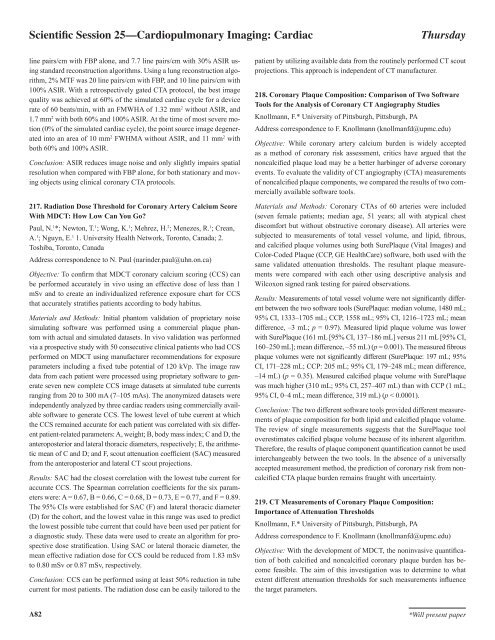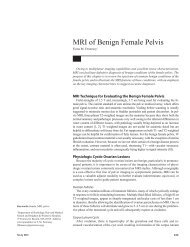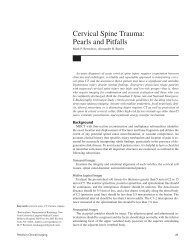Scientific Session 1 â Breast Imaging: Mammography
Scientific Session 1 â Breast Imaging: Mammography
Scientific Session 1 â Breast Imaging: Mammography
Create successful ePaper yourself
Turn your PDF publications into a flip-book with our unique Google optimized e-Paper software.
<strong>Scientific</strong> <strong>Session</strong> 25—Cardiopulmonary <strong>Imaging</strong>: CardiacThursdayline pairs/cm with FBP alone, and 7.7 line pairs/cm with 30% ASIR usingstandard reconstruction algorithms. Using a lung reconstruction algorithm,2% MTF was 20 line pairs/cm with FBP, and 10 line pairs/cm with100% ASIR. With a retrospectively gated CTA protocol, the best imagequality was achieved at 60% of the simulated cardiac cycle for a devicerate of 60 beats/min, with an FMWHA of 1.32 mm 2 without ASIR, and1.7 mm 2 with both 60% and 100% ASIR. At the time of most severe motion(0% of the simulated cardiac cycle), the point source image degeneratedinto an area of 10 mm 2 FWHMA without ASIR, and 11 mm 2 withboth 60% and 100% ASIR.Conclusion: ASIR reduces image noise and only slightly impairs spatialresolution when compared with FBP alone, for both stationary and movingobjects using clinical coronary CTA protocols.217. Radiation Dose Threshold for Coronary Artery Calcium ScoreWith MDCT: How Low Can You Go?Paul, N. 1 *; Newton, T. 1 ; Wong, K. 1 ; Mehrez, H. 2 ; Menezes, R. 1 ; Crean,A. 1 ; Nguyn, E. 1 1. University Health Network, Toronto, Canada; 2.Toshiba, Toronto, CanadaAddress correspondence to N. Paul (narinder.paul@uhn.on.ca)Objective: To confirm that MDCT coronary calcium scoring (CCS) canbe performed accurately in vivo using an effective dose of less than 1mSv and to create an individualized reference exposure chart for CCSthat accurately stratifies patients according to body habitus.Materials and Methods: Initial phantom validation of proprietary noisesimulating software was performed using a commercial plaque phantomwith actual and simulated datasets. In vivo validation was performedvia a prospective study with 50 consecutive clinical patients who had CCSperformed on MDCT using manufacturer recommendations for exposureparameters including a fixed tube potential of 120 kVp. The image rawdata from each patient were processed using proprietary software to generateseven new complete CCS image datasets at simulated tube currentsranging from 20 to 300 mA (7–105 mAs). The anonymized datasets wereindependently analyzed by three cardiac readers using commercially availablesoftware to generate CCS. The lowest level of tube current at whichthe CCS remained accurate for each patient was correlated with six differentpatient-related parameters: A, weight; B, body mass index; C and D, theanteroposterior and lateral thoracic diameters, respectively; E, the arithmeticmean of C and D; and F, scout attenuation coefficient (SAC) measuredfrom the anteroposterior and lateral CT scout projections.Results: SAC had the closest correlation with the lowest tube current foraccurate CCS. The Spearman correlation coefficients for the six parameterswere: A = 0.67, B = 0.66, C = 0.68, D = 0.73, E = 0.77, and F = 0.89.The 95% CIs were established for SAC (F) and lateral thoracic diameter(D) for the cohort, and the lowest value in this range was used to predictthe lowest possible tube current that could have been used per patient fora diagnostic study. These data were used to create an algorithm for prospectivedose stratification. Using SAC or lateral thoracic diameter, themean effective radiation dose for CCS could be reduced from 1.83 mSvto 0.80 mSv or 0.87 mSv, respectively.Conclusion: CCS can be performed using at least 50% reduction in tubecurrent for most patients. The radiation dose can be easily tailored to thepatient by utilizing available data from the routinely performed CT scoutprojections. This approach is independent of CT manufacturer.218. Coronary Plaque Composition: Comparison of Two SoftwareTools for the Analysis of Coronary CT Angiography StudiesKnollmann, F.* University of Pittsburgh, Pittsburgh, PAAddress correspondence to F. Knollmann (knollmanfd@upmc.edu)Objective: While coronary artery calcium burden is widely acceptedas a method of coronary risk assessment, critics have argued that thenoncalcified plaque load may be a better harbinger of adverse coronaryevents. To evaluate the validity of CT angiography (CTA) measurementsof noncalcified plaque components, we compared the results of two commerciallyavailable software tools.Materials and Methods: Coronary CTAs of 60 arteries were included(seven female patients; median age, 51 years; all with atypical chestdiscomfort but without obstructive coronary disease). All arteries weresubjected to measurements of total vessel volume, and lipid, fibrous,and calcified plaque volumes using both SurePlaque (Vital Images) andColor-Coded Plaque (CCP, GE HealthCare) software, both used with thesame validated attenuation thresholds. The resultant plaque measurementswere compared with each other using descriptive analysis andWilcoxon signed rank testing for paired observations.Results: Measurements of total vessel volume were not significantly differentbetween the two software tools (SurePlaque: median volume, 1480 mL;95% CI, 1333–1705 mL; CCP, 1558 mL; 95% CI, 1216–1723 mL; meandifference, –3 mL; p = 0.97). Measured lipid plaque volume was lowerwith SurePlaque (161 mL [95% CI, 137–186 mL] versus 211 mL [95% CI,160–250 mL]; mean difference, –55 mL) (p = 0.001). The measured fibrousplaque volumes were not significantly different (SurePlaque: 197 mL; 95%CI, 171–228 mL; CCP: 205 mL; 95% CI, 179–248 mL; mean difference,–14 mL) (p = 0.35). Measured calcified plaque volume with SurePlaquewas much higher (310 mL; 95% CI, 257–407 mL) than with CCP (1 mL;95% CI, 0–4 mL; mean difference, 319 mL) (p < 0.0001).Conclusion: The two different software tools provided different measurementsof plaque composition for both lipid and calcified plaque volume.The review of single measurements suggests that the SurePlaque tooloverestimates calcified plaque volume because of its inherent algorithm.Therefore, the results of plaque component quantification cannot be usedinterchangeably between the two tools. In the absence of a universallyaccepted measurement method, the prediction of coronary risk from noncalcifiedCTA plaque burden remains fraught with uncertainty.219. CT Measurements of Coronary Plaque Composition:Importance of Attenuation ThresholdsKnollmann, F.* University of Pittsburgh, Pittsburgh, PAAddress correspondence to F. Knollmann (knollmanfd@upmc.edu)Objective: With the development of MDCT, the noninvasive quantificationof both calcified and noncalcified coronary plaque burden has becomefeasible. The aim of this investigation was to determine to whatextent different attenuation thresholds for such measurements influencethe target parameters.A82*Will present paper
















